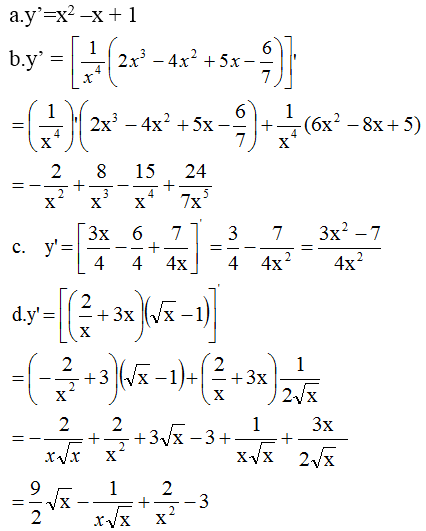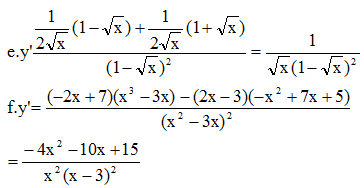Hãy nhập câu hỏi của bạn vào đây, nếu là tài khoản VIP, bạn sẽ được ưu tiên trả lời.

\(y=\dfrac{1}{2x^2+x-1}=\dfrac{1}{\left(x+1\right)\left(2x-1\right)}=\dfrac{2}{3}.\dfrac{1}{2x-1}-\dfrac{1}{3}.\dfrac{1}{x+1}\)
\(y'=\dfrac{2}{3}.\dfrac{-2}{\left(2x-1\right)^2}-\dfrac{1}{3}.\dfrac{-1}{\left(x+1\right)^2}=\dfrac{2}{3}.\dfrac{\left(-1\right)^1.2^1.1!}{\left(2x-1\right)^2}-\dfrac{1}{3}.\dfrac{\left(-1\right)^1.1!}{\left(x+1\right)^2}\)
\(y''=\dfrac{2}{3}.\dfrac{\left(-1\right)^2.2^2.2!}{\left(2x-1\right)^3}-\dfrac{1}{3}.\dfrac{\left(-1\right)^2.2!}{\left(x+1\right)^3}\)
\(\Rightarrow y^{\left(n\right)}=\dfrac{2}{3}.\dfrac{\left(-1\right)^n.2^n.n!}{\left(2x-1\right)^{n+1}}-\dfrac{1}{3}.\dfrac{\left(-1\right)^n.n!}{\left(x+1\right)^{n+1}}\)
\(\Rightarrow y^{\left(2019\right)}=\dfrac{2}{3}.\dfrac{\left(-1\right)^{2019}.2^{2019}.2019!}{\left(2x-1\right)^{2020}}-\dfrac{1}{3}.\dfrac{\left(-1\right)^{2019}.2019!}{\left(x+1\right)^{2020}}\)
\(=\dfrac{2019!}{3}\left(\dfrac{1}{\left(x+1\right)^{2020}}-\dfrac{2^{2020}}{\left(2x-1\right)^{2020}}\right)\)

a) Cách 1: Ta có:
y' = 6sin5x.cosx - 6cos5x.sinx + 6sinx.cos3x - 6sin3x.cosx = 6sin3x.cosx(sin2x - 1) + 6sinx.cos3x(1 - cos2x) = - 6sin3x.cos3x + 6sin3x.cos3x = 0.
Vậy y' = 0 với mọi x, tức là y' không phụ thuộc vào x.
Cách 2:
y = sin6x + cos6x + 3sin2x.cos2x(sin2x + cos2x) = sin6x + 3sin4x.cos2x + 3sin2x.cos4x + cos6x = (sin2x + cos2x)3 = 1
Do đó, y' = 0.
b) Cách 1:
Áp dụng công thức tính đạo hàm của hàm số hợp
(cos2u)' = 2cosu(-sinu).u' = -u'.sin2u
Ta được
y' =[sin - sin
] + [sin
- sin
] - 2sin2x = 2cos
.sin(-2x) + 2cos
.sin(-2x) - 2sin2x = sin2x + sin2x - 2sin2x = 0,
vì cos = cos
=
.
Vậy y' = 0 với mọi x, do đó y' không phụ thuộc vào x.
Cách 2: vì côsin của hai cung bù nhau thì đối nhau cho nên
cos2 = cos2
'
cos2 = cos2
.
Do đó
y = 2 cos2 + 2cos2
- 2sin2x = 1 +cos
+ 1 +cos
- (1 - cos2x) = 1 +cos
+ cos
+ cos2x = 1 + 2cos
.cos(-2x) + cos2x = 1 + 2
cos2x + cos2x = 1.
Do đó y' = 0.

a) Cách 1: y' = (9 -2x)'(2x3- 9x2 +1) +(9 -2x)(2x3- 9x2 +1)' = -2(2x3- 9x2 +1) +(9 -2x)(6x2 -18x) = -16x3 +108x2 -162x -2.
Cách 2: y = -4x4 +36x3 -81x2 -2x +9, do đó
y' = -16x3 +108x2 -162x -2.
b) y' = .(7x -3) +
(7x -3)'=
(7x -3) +7
.
c) y' = (x -2)'√(x2 +1) + (x -2)(√x2 +1)' = √(x2 +1) + (x -2) = √(x2 +1) + (x -2)
= √(x2 +1) +
=
.
d) y' = 2tanx.(tanx)' - (x2)' =
.
e) y' = sin
=
sin
.

\(\lim\limits_{x\rightarrow1}\dfrac{x^3-3x+2}{x^4-4x+3}=\lim\limits_{x\rightarrow1}\dfrac{\left(x+2\right)\left(x-1\right)^2}{\left(x^2+2x+3\right)\left(x-1\right)^2}=\lim\limits_{x\rightarrow1}\dfrac{x+2}{x^2+2x+3}=\dfrac{1}{2}\)
\(\lim\limits_{x\rightarrow2^-}\dfrac{x^3+x^2-4x-4}{x^2-4x+4}=\lim\limits_{x\rightarrow2^-}\dfrac{\left(x-2\right)\left(x^2+3x+2\right)}{\left(x-2\right)^2}=\lim\limits_{x\rightarrow2^-}\dfrac{x^2+3x+2}{x-2}=-\infty\)
\(\lim\limits_{x\rightarrow2}\dfrac{\left(x^2-x-2\right)^{20}}{\left(x^3-12x+16\right)^{10}}=\lim\limits_{x\rightarrow2}\dfrac{\left(x+1\right)^{20}\left(x-2\right)^{20}}{\left(x+4\right)^{10}\left(x-2\right)^{20}}=\lim\limits_{x\rightarrow2}\dfrac{\left(x+1\right)^{20}}{\left(x+4\right)^{10}}=\dfrac{3^{10}}{2^{10}}\)
\(\lim\limits_{x\rightarrow0^-}\dfrac{4x^2+5x}{x^2}=\lim\limits_{x\rightarrow0^-}\dfrac{4x+5}{x}=-\infty\)
\(\lim\limits_{x\rightarrow-1}\dfrac{\sqrt{x+2}-1}{\sqrt{x+5}-2}=\lim\limits_{x\rightarrow-1}\dfrac{\left(x+1\right)\left(\sqrt{x+5}+2\right)}{\left(x+1\right)\left(\sqrt{x+2}+1\right)}=\lim\limits_{x\rightarrow-1}\dfrac{\sqrt{x+5}+2}{\sqrt{x+2}+1}=2\)


\(y=\dfrac{1}{3x^2-x-2}=\dfrac{1}{\left(x-1\right)\left(3x+2\right)}=\dfrac{1}{5}.\dfrac{1}{x-1}-\dfrac{3}{5}.\dfrac{1}{3x+2}\)
\(y'=\dfrac{1}{5}.\dfrac{\left(-1\right)^1.1!}{\left(x-1\right)^2}-\dfrac{3}{5}.\dfrac{\left(-1\right)^1.3^1.1!}{\left(3x+2\right)^2}\)
\(y''=\dfrac{1}{5}.\dfrac{\left(-1\right)^2.2!}{\left(x-1\right)^3}-\dfrac{3}{5}.\dfrac{\left(-1\right)^2.3^2.2!}{\left(3x+2\right)^3}\)
\(\Rightarrow y^{\left(n\right)}=\dfrac{1}{5}.\dfrac{\left(-1\right)^n.n!}{\left(x-1\right)^{n+1}}-\dfrac{3}{5}.\dfrac{\left(-1\right)^n.3^n.n!}{\left(3x+2\right)^{n+1}}\)
\(\Rightarrow y^{\left(2019\right)}=\dfrac{1}{5}.\dfrac{\left(-1\right)^{2019}.2019!}{\left(x-1\right)^{2020}}-\dfrac{3}{5}.\dfrac{\left(-1\right)^{2019}.3^{2019}.2019!}{\left(3x+2\right)^{2019}}\)
\(=\dfrac{2019!}{5}\left(\dfrac{3^{2020}}{\left(3x+2\right)^{2020}}-\dfrac{1}{\left(x-1\right)^{2020}}\right)\)